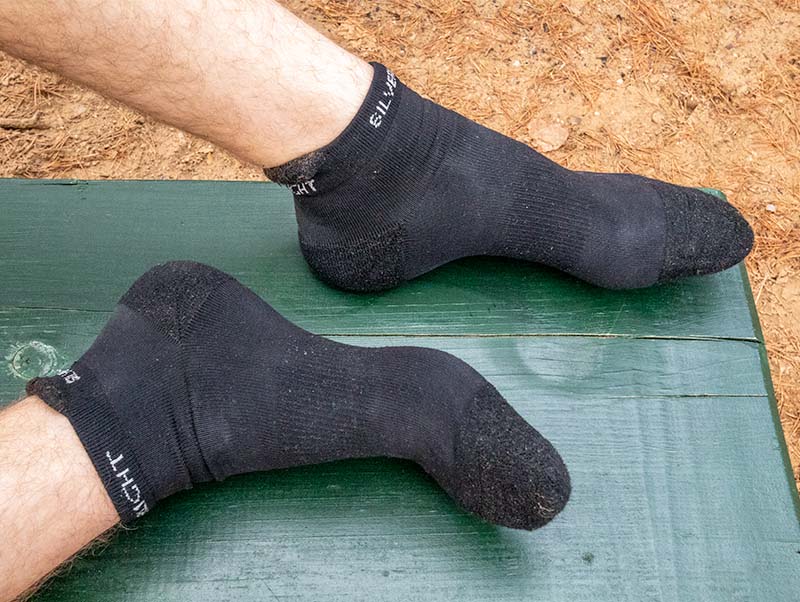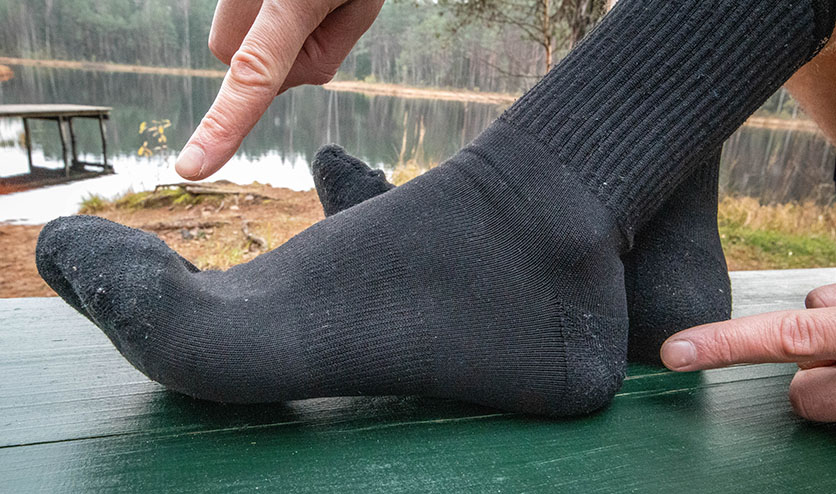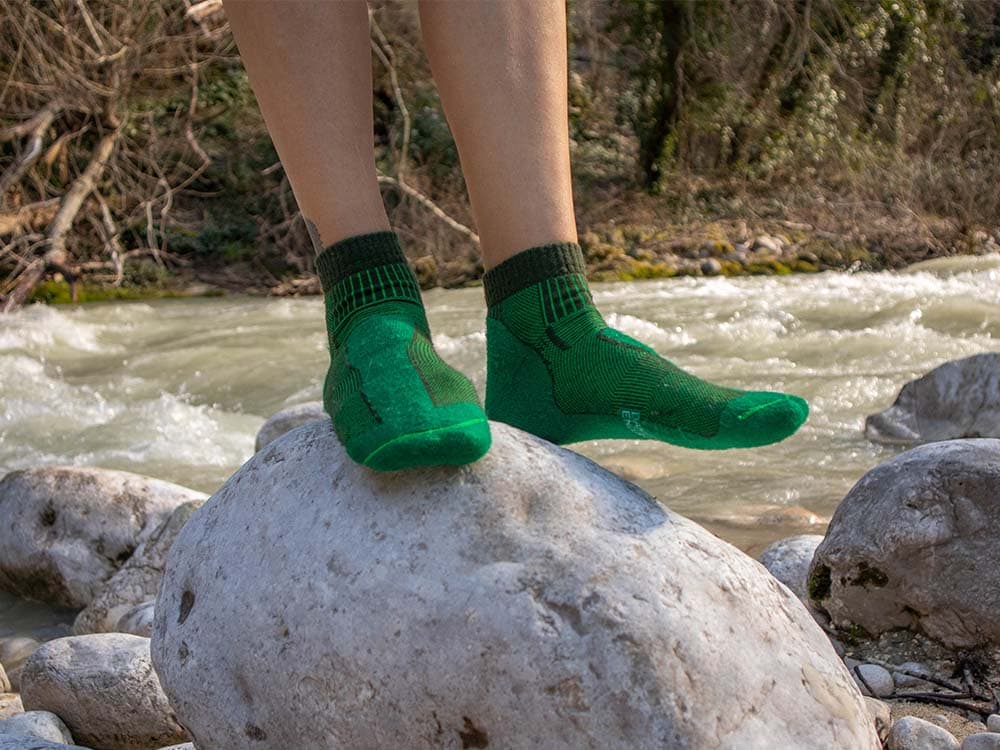If you can get a pair of regular synthetic running socks for 1-2$, why would you pay 20-30$ for a pair of hiking socks?
I was asking the same question when I just started out hiking, but slowly, over time, I’ve now switched to wearing more expensive merino wool hiking socks. By slowly I mean I switched to cheap synthetic hiking socks first, then cheap merino wool socks, and finally to good merino wool hiking socks. Over time, I’ve learned that expensive hiking socks are indeed necessary.
In this article, I’ll be comparing the differences between a pair of good hiking socks and typical, cheap 1-2$ synthetic running socks. I’ll also be sharing my own experience, and tell you why I kept switching to more expensive socks over time.
The Main Differences Between Hiking Socks And Regular Socks

Blister Resistance
I used to get blisters all the time when I just started out, and I was always taping my toes and heels for blisters because I was hiking with typical synthetic running/sporting socks (synthetic because I knew that cotton is super bad for hiking). So over time, I started experimenting with better socks made from better materials. With every upgrade, I started to have fewer blisters. But I stopped having blisters entirely only when I switched to a pair of good, expensive merino wool socks. And in my opinion, getting blisters is the worst thing that can happen while hiking because it can totally ruin your motivation and experience. This is the main reason why I think good hiking socks are worth it.
Durability
Hiking socks will usually outlast regular sports socks for much longer because they’re specifically made to withstand extended periods of activity. So if you’d invest in a pair of good hiking socks, they would most likely last you through many hiking seasons and many thru-hikes.
There is one caveat though. Hiking socks with a higher merino wool percentage will be less durable because pure merino wool breaks down rather quickly. Socks that will last longer will have a higher percentage of synthetics in them (nylon or polyester), between 40-70%.
Comfort And Padding
Good hiking socks will have more padding on the heel, the toes, and sometimes on the top and ball areas of the feet as well. This will improve the overall comfort of your feet and reduce blister formation in key areas.
Hiking socks also have a seamless design around the toebox and are better fitted for your toes, which reduces the amount of loose fabric and rubbing around the toes.
Compression
Most expensive hiking socks will also offer some kind of compression. For example, my Silverlight merino wool socks have compression panels on the middle part of the feet and over the ankle. This allows the sock to fit snugly on my feet without any movement, which is really important for avoiding blisters.
Odor Control
Wool, merino wool, and hiking socks that contain Silver yarns will also start to develop bad odors much more slowly compared to regular sports socks. That’s because these materials are antimicrobial. Wool creates an environment inside it that limits the growth of bacteria and silver actively kills it. And with fewer bacteria, the socks smell fresh for longer. In my experience, regular socks will start to smell after a single day of hiking, whereas good merino wool hiking socks only after 2-3 days.
Cooling And Breathability
Most good hiking socks will be made from merino wool, which is really beneficial when hiking in the summer. Merino wool is a much more breathable material than synthetics or cotton, which limits the sweating of your feet. It’s also thermoregulating, which means that it soaks up the sweat from your feet over time and releases it through the exterior, which allows your feet to stay dry even when being active.
Insulation And Warmth
In the winter, thicker merino wool socks will warm your feet much more than typical cotton or synthetic socks. That’s because wool traps a lot of air inside it, which acts as an insulating layer between your skin and the outside.
Drying Time
Good merino wool hiking socks will actually dry slower than regular sports socks, especially if they have a high wool percentage. That’s because wool dries very slowly, and the drying time is mostly affected by how much polyester, nylon, or Coolmax synthetics are in the fabric.
Cost
Good hiking socks cost a lot, even 10-20x more than regular sports socks. Most good hiking socks are priced above 20$ and can even go upwards of 40$ in some cases.
Summing Up: Are Expensive Hiking Socks Worth It?

After switching between various types of socks, ranging between cheap running socks and expensive merino wool hiking socks, I would most definitely recommend going with the more expensive option. For all hikers, even beginners, I would recommend getting two pairs of good hiking socks in the 20-30$ price range for each one.
It may seem like a lot, but it really isn’t. You won’t be dealing with blisters anymore and you’ll have a more pleasant experience overall. Plus, good hiking socks tend to last several years of intense hiking. Spending 40-60$ every few years in my opinion really is not a lot, when considering that the other option is to spend 5$ but have painful areas on your feet after every hike.
Frequently Asked Questions
How do I choose a pair of good hiking socks?
First of all, you have to choose a sock that’s made from a fabric that contains 30-70% merino wool, 30-70% nylon or polyester, and 1-5% elastane or spandex. This material combination will provide the perfect mix of durability, thermoregulation, odor resistance, and drying time.
Next, you have to figure out how long the hiking socks should be. Ideally, they have to stay 1-2 inches over your footwear, but the more the better. Hiking socks and grouped into several different types of lengths: no-show, ankle (other called quarter or 1/4), micro crew, crew, and knee-high. I would recommend going with ankle or micro crew length in the summer, and micro crew or crew in the winter.
After that, you have to determine what thickness sock you’ll need – ultra-lightweight, lightweight, midweight, or heavyweight. Generally, for summer hiking I recommend lightweight hiking socks, and for winter midweight.
Finally, you should also consider a few other factors. For example, the sock has to have some form of padding on the heel and the toebox at the bare minimum. It should generally be 1 size below your real size to provide a good, but not too tight fit. As an added bonus it could also have breathable mesh panels, compression panels, two-layer construction, or could have silver yarns knitted into the fabric.
Read Next: What Socks To Wear With Hiking Boots
Which brands make the best hiking socks?
There are quite a lot of brands that make good hiking socks. Most socks made by the following brands will be of good quality – Darn Tough, Smartwool, Silverlight, Danish Endurance, Farm to Feet, FoxRiver, Injinji, and Stance. I wouldn’t recommend going with cheap, lesser-known brands from Amazon though, as I’ve only had a poor experience with them.
Which are the best hiking socks for summer?
Summer hiking socks should ideally contain a bit smaller percentage of merino wool so that the sock can dry quicker and is more durable, ideally in the 40-60% range. They should be breathable, not very thick (ultra-lightweight or lightweight), not very long (ankle, micro crew, or crew), and they should have good antibacterial properties.
I finished my 500-mile thru-hike in Spain when the temperatures often were above 30 C / 86 F, with two pairs of socks from Silverlight – the no-show and the crew models. Most of the time, I wore the no-show model, but the crew one was useful for sleeping and for very rainy and cold days. I didn’t get a single blister, they dried within a few hours after washing in a nearby stream, and they were very comfortable during the whole hike. Plus, I’m still using them today, two years later.
Which are the best hiking socks for winter?
For winter, your hiking socks should have a higher merino wool percentage, ideally between 50-80%. This will allow for better insulation and thermoregulation. They should be pretty thick (midweight but in extreme cold heavyweight), long enough (crew or knee-high), and have plenty of padding all around.
The best ones that I’ve found so far are the Darn Tough Merino Wool Full Cushion Boot hiking socks. They come with plenty of padding and cushioning (midweight), they’re the correct length (crew), they have 66% merino wool content, and they’ve gotten excellent reviews. They’re also really great for high-altitude hiking during the summer because they’re very breathable, but at the same time provide enough insulation for cold weather.
What hiking socks are the best for preventing blisters?
The best hiking socks for preventing blisters will have to fit your feet perfectly and contain 30-70% merino wool. The merino wool will help keep your feet dry while being active and create an environment where bacteria don’t grow very well, greatly contributing to the overall blister resistance. The sock also needs some padding around the heel and toe area, where blisters are most likely to form, and also have a bit of compression, which will improve the fit and keep it from moving around your feet.
One of my favorite hiking socks for preventing blisters is the Darn Tough Micro Crew Cushion merino wool hiking socks. It has 63% merino wool, enough cushioning, compressed fabric over the ankle and the middle part of your feet, and a seamless design around the toes, which doesn’t leave any excess fabric rubbing against your toes.
